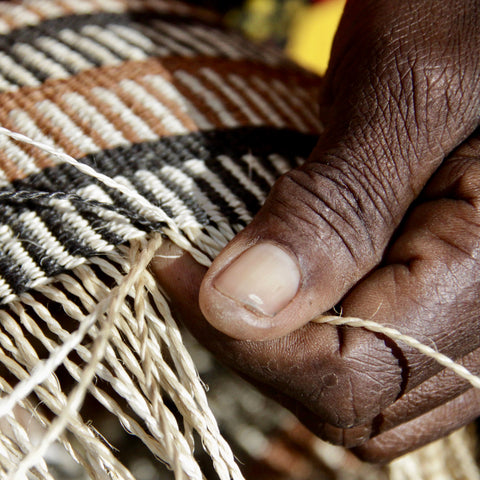Fineweave Baskets - The Making of

For the Fineweave roots and Fineweave fusion collection the Hadithi team works with 285 traditional taita basket weavers. They live in and around the Taita Hills.
The Taita hills are a green lush area, with maize and even rice growing on its flanks, as it receives more rainfall thanks to its high altitude. A breath of fresh air in a semi-desert.
The weavers here grow and process their own sisal. All of them belong to a women's group in their village. They meet weekly and weave together. They also support each other with loans and valuable advice on all kinds of practical and emotional matters.
Their baskets are organic and 100% locally produced (hand-woven out of home-grown natural sisal fibre). Each of the fineweave roots baskets is one of a kind and tells its own story.
 |
 |
 |
Traditional preparation of the sisal
The making of fineweave baskets starts with a different process than the making of practical baskets.
Thanks to higher rainfall and fewer elephants in Taita hills compared to the more dry areas where the practical basket weavers live, basket weavers in the Taita hills grow their own sisal at their homesteads and farms. So they prepare their sisal fibre for weaving by hand themselves.
The weaver first harvests the inner leaves of sisal from her sisal plants. Doing that, she must be careful not to destroy the plant by removing all its newer leaves which inhibits its new growth.
Now she strips (decorticates) them by hand. This is done by pulling it between two sticks until the green juicy parts are all stripped off and only the white fibre remains. Then, it's laid out to dry.
She can only use the soft inner leaves of the sisal plant, as the tougher outer leaves of the sisal plant are too hard to strip by hand. The outer leaves can only be stripped industrially and this is the sisal we use for the making of practical weave baskets (read more about sisal in the sisal story).
Interestingly, one single strand of an inner leaf fibre is thinner than a strand of the outer leaf of a sisal plant. Meaning, with industrially processed sisal from the outer leaves, one can never reach a basket of the same finesse and soft feel as the traditional fineweave baskets, no matter how experienced the weaver is!
 |
 |
 |
In our Fineweave roots collection, colours only come from the natural dyeing - using earth, tree bark and leaves or by burying the fibre underground next to certain plant roots. Bright colours of the Fineweave fusion collection, are obtained with textile dyes.
 |
 |
 |
 |
 |
 |
The weaver will now make her sisal fibre into twine. Twining might be the most time-consuming part of the whole basket weaving process! The dried fibres are firmly rolled into threads, which works best on a bare thigh (ouch!). A consistent amount of fibers has to be selected each time, to keep the same thickness overall. Several hours, even days will pass before they are able to obtain enough twine to weave a full basket. The inside part is twined fatter and with less precision, as it should be invisible once the basket is woven.
 |
 |
 |
From here, the basic techniques are the same as for practical baskets. It will just take a longer time to weave the traditional basket as the sisal twine is so much thinner. Traditionally, the diameter of the bottom of the basket is a lot smaller than the top. Also there are a few different traditional techniques to make the upper rim.
The basket weaving
The basket technique the Taita weavers use is called Twining Basketry. Twining refers to a weaving technique where two or more flexible weaving elements (weavers) cross each other as they wave through the stiffer radial spokes (that we call maleri). In twined baskets, two or more flexible elements are used to encircle another base element. When two weavers are used, this technique is called pairing.
 |
 |
 |
Weaving starts in the middle at the bottom of the basket. How long it takes to weave one basket depends on the size, but also varies a lot from weaver to weaver, depending on her experience, skills and the time she has available in her daily life as a farmer. And finally, the thinner her twine and the more intricate her patterns, the longer it will take...
Now its time for the fun part, where the creativity can flow freely and pieces of art are created! Unique patterns and decorative weaves allow to demonstrate real artistry. Styles range from very intricate and subtle to crazy, edgy and full of character.
Finishing off the basket is the last step in the making of, when the weaver adds a firm upper rim and then trims off the last sticky-outy bits of sisal with scissors… now the basket is completed. The weaver writes her name on a piece of cardboard and ties it to the basket. Her work is done.
 |
 |
 |
Mercy of the Hadithi team goes to the different villages to meet the weavers and buy their baskets. Mercy is the daughter of a basket weaver herself. When she goes basketbuying she also gives feedback on past orders, supplies more materials to the groups and gives them additional trainings in basket weaving. She carries the new baskets to the Hadithi Headquarters.
 |
 |
 |

